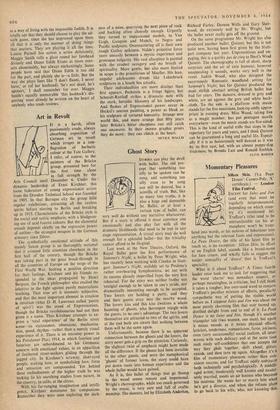Art in Revolt
IT is a harsh, often passionately crude, always absorbing exposition of German art in revolt which irrupts in a con- flagration of barbaric colour at the Tate Gallery. I refer, of course, to the painters of the Brticke group, presented here for the first time alone in full strength by the Arts Council until December 6. Under the dynamic leadership of Ernst Kirchner, this loose federation of young expressionist artists from the Dresden Technical School was founded in 1905. In that Baroque city the group lreld regular exhibitions, attracting all the restless spirits before n-loving to Berlin and breaking up in 1913. Characteristic of the Brilcke style is the social and satiric emphasis, with a bludgeon- ing use of acid fauvist colours. But the elemental assault depends chiefly on the expressive power of outline—the strongest weapon in the German armoury since Dtirer.
The symbolically emotional attitude of this mainly Saxon group is so thoroughly national that it aroused little attention elsewhere in the first half of the century, though the BrOcke was ,taking part in the great break-through in all the countries of Europe on the verge of the First World War. Seeking a positive direction for their feelings, Kirchner and his friends re- sponded to the ideas propagated by Henri Bergson, the French philosopher who exalted the intuitive in the fight against purely materialistic teaching. That true art is intensely subjective, and that the most important element in creation is intuition (what D. H. Lawrence called 'purity of spirit') was the creed of Expressionism, though the Briicke revolutionaries had not then given it a name. Thus Kirchner attempts to ex- press a 'total experience' of the Berlin street scene—its viciousness, obsessions, mechanisa- tion, speed, rhythm—rather than a merely visual experience of it. There is an uncanny power in his Potsdamer Platz 1914, in which fauvism and futurism are subordinated to his Germanic concern with emotional values, in an apparition of feathered street-walkers gliding through the jagged city. In Kirchner's scrawny, slant-eyed people, making love, or symbolising love, form and sensation are compounded. Yet behind these embodiments of the higher truth he was seeking lie his searching studies from nature, in the country, in cafes, at the circus.
With his far-ranging imagination and intelli- gence, Kirchner dominates his companions. Remember they were men exploring the dark-
ness of a mine, quarrying the next piece of rock and hacking often clumsily enough. Urgently they turned to impassioned models, to Van Gogh, Gauguin and Munch, to Negro and Pacific sculpture. Overmastering all is their own rough Gothic spikiness. Nolde's primitive force veers uneasily between a mystic experience and grotesque vulgarity. His vast altarpiece is painted with the crudest savagery and no breath of spirituality. More gentle, but also more limited in scope is the primitivism of Mueller. His lean. angular adolescents dream like Lehmbruck sculptures in a South Sea arcadia.
Their individualities are more distinct than first appears. Pechstein is a fringe figure, but Schmidt-Rottluff strikes a dramatic note with the stark, heraldic blazonry of his landscapes. And flashes of Expressionist power occur in Heckel's uneven painting, a power as bleak as his sculpture of tortured humanity. Strange new world this, and more strange that fifty years later BrOcke's bitter sharpness can still catch one unawares. In their intense graphic prints they do more: they can clutch at the heart.
' NEVILE WALLIS
































 Previous page
Previous page